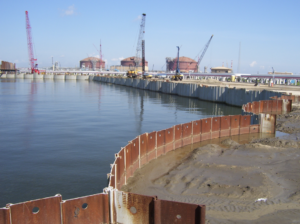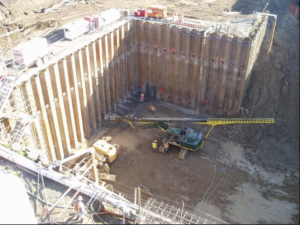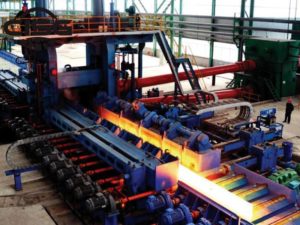The application of steel sheet pile in bridge infrastructure construction
1.0 Introduction
With the fast development of communication in China, the density of highways network improves continuously. The large span bridge is constantly emerging, especially in Jiangsu and Zhejiang, the most urbanized area of China. Full of rivers and lakes is another feature in this area. Many highways need to cross waterways by bridges with a great navigation height and large span. For most bridges, a concrete cap is built at the top of the pile foundation, but in this case, this cap is often underwater. It means that the conventional dry construction is not valid. The effective measure is required to provide conditions for starting dry construction and ensure the quality of the project. Therefore, steel sheet pile cofferdams are widely used in bridge foundation construction. The dry construction condition is achieved by inserting steel sheets pile into the riverbed and forming an enclosure. The steel sheet pile cofferdam may have many shapes, such as rectangular, square, circular and flat.
2.0 The design requirements for steel sheet pile cofferdam
2.1 The selection of steel sheet pile
In China, SP-IV or SP-V steel sheet piles are two typical lengths of steel sheet pile. The specific length of this steel sheet pile is determined by the geological and water depth conditions of the construction area. The bottom mark of the standard steel sheet pile is 6~10 m higher or lower than the bed elevation. Its crest level is 0.5~1 m higher than its highest water level during the construction period.
2.2 Plane size design of steel sheet pile cofferdam
The plane size of the steel sheet pile raft is determined by the size of the bridge platform and is generally 1.5~2.0 m larger than the circumference of the pile. The modulus of the steel sheet pile is another factor that people need to consider.
2.3 Inner support design after the steel sheet pile cofferdam
After an enclosure is formed by these steel sheet pile, the cofferdam needs to be drained from the water, and some of the soil needs to be removed. Since the water is pumped, there will be tremendous pressure generated on the steel sheet pile by the different height of water between the inside and the outside of the cofferdam. Under this case, supporting the steel sheet pile to resist the side pressure of the water is the next step.
3.0 Construction method
3.1 Steel sheet pile preparation
Before steel sheet piles are transported to the construction site, a detailed check on these piles is required. This is because the steel sheet pile may be a mixture of old and new material with the unknown quality. In this checking process, an experiment on a length of 2~3 m at the lock on both sides by using the same type of short pile is recommended. It is advisable to have 2~3 persons to use this short pile to pull and pass through the lock or use an elevator to drag. When conditions permit, using inspection trolley is suggested. When the lock cannot be passed through, or some other defects appear, such as bending, twisting or dog leg, methods like cold bending, hot knocking (temperature does not exceed 800~ 1000 ℃), welding, riveting, cutting and lengthening are taken to repair the piles. For welding process, butt welding is the first step, following by welding to reinforce plate. Moreover, for long welding, an active clamp is required to avoid deformation. In the lock of the sheet pile, grease mixture ointment (quality ratio among grease, asphalt, dry sawdust and dry clay is 2:2:2:1) is applied to reduce friction during inserting steel sheet pile and impermeability of the enclosure.
3.2 The selection of pile driving machinery
Generally, hoisting equipment for inserting steel sheet pile is floating crane or pile hammer. If the project is an entire over-water construction, a floating crane is the first choice. The sling angle, span, and hoisting capacity of a crane are factors that need to be considered before selecting the machine. Pile hammer often uses a vibratory hammer and corresponding hydraulic clamp. The size of the vibratory hammer is selected based on the geological condition of the construction site.
3.3 Insertion of gauge pile
For most cases, gauge piles are inserted in a line parallel to the cofferdam edge line. For the material of this gauge piles, Φ609 steel sheet pile are often used to be the gauge piles, and steel sheet pile is the second choice. To ensure these piles are in the right positions, theodolite is an instrument selected for checking. Gauge piles are usually 1~1.5m away from the border of the cofferdam, and the spacing between these gauge piles is suggested to be 5~7 m.
3.4 Installation of launching nose
The existing steel sheet pile can be used for setting up launching nose, which is a platform for operation. The width of launching nose is determined by the width of the cofferdam wall body, and the interspace in the middle of launching nose is approximately 20 cm greater than the width of the wall body.
3.5 Insertion of steel sheet pile
At first, there is a need to mark the position of each steel sheet pile on the surface of launching nose, and then insertion of steel sheet piles starts from the centre to two directions. After installing one side of the steel sheet pile, the launching nose needs to be removed. For the rest part of the cofferdam, the same procedure should be repeated.
3.6 Pumping water, welding and support
After the cofferdam is closed, inner annular support can be set at the top of the pile, following by pumping water. When the water level is 1 meter lower than support, pumping should be stopped. Another inner annular support needs to be set, and then start to pump again. Then, this procedure should be repeated until the steel sheet pile fully supports.
3.7 Leaking stoppage
Water leakage usually appears at the lock of the old steel sheet pile, and yellow sand is a solution. Dumping it into the water until its stack covers the leak will fix the problem.
3.8 Removal of the cofferdam
When the construction of the pier cap is completed, cofferdam can be removed. Before removal, it shall clean up the temporary joints inside and outside the cofferdam. The next step is pumping water into the cofferdam to about 1 m below the lowest horizontal inner support, and remove this inner support. Then, workers keep to inject water to the next horizontal inner support and remove this support, repeating this procedure until removing all the supports. Also, use a vibrating hammer to pull up all steel sheet pile.
4.0 Quality control
(1) To ensure the successful assembly of pitching of the pile, it requires the pile body to be vertical, and the number of steel plates around the cofferdam should be evenly distributed.
The first steel sheet pile must be completely vertical and perpendicular to the horizontal level. Since the upper and lower widths of the steel sheet pile are not equal, the pile body is very likely to tilt. Under this case, it is necessary to strengthen measurement work during construction. When an inclination is detected, a timely adjustment is required, ensuring the inclination of each group of steel sheet pile in the surrounding direction along cofferdam and its vertical direction is no more than 5%.
(2) When splicing steel sheet pile with long splicing length are used, splicing joints of steel sheet pile should not be on the same section of the cofferdam. Moreover, joints of adjacent piles should be staggered up and down by at least 2 m. Therefore, piles should be prepared in advance for splicing steel sheet pile, and stacked in the order of piling when transporting and storing.
(3) For inserting and driving steel sheet pile, if the perpendicularity of steel sheet pile is under the excellent condition, the pile should be driven to the set depth at once. If the perpendicularity is poor, the pile should be forced to the set depth at two times. For the second case, all the piles are driven into about half of the depth, and the second time should be forced to the required depth.
(4) During the use of steel sheet pile cofferdam, workers need to prevent the water level in the cofferdam from being higher than the water level outside the cofferdam. The first step is to connect the pipe at the low water level and close it when pumping water in the cofferdam. Also, it is necessary to control pumping progress. When the water level reaches each layer of inner support, the inner support should be set up in time.




